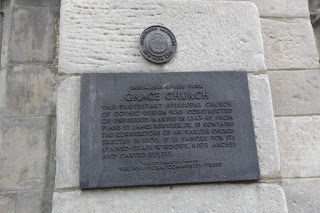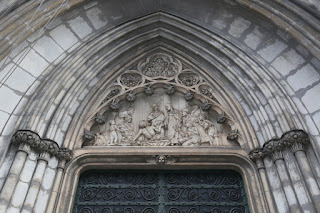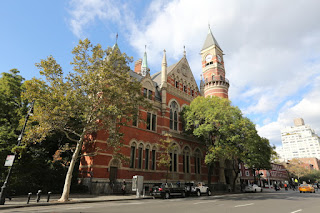Another brother, Henry Codman Potter, notable for his early leadership in the Social Gospel movement, was the rector there from 1868 to 1884. He presided over expanding programs offered by the church to immigrants, who were arriving in ever-increasing numbers; these included day care and teaching skills that would lead to employment.
I was fascinated to learn of one parishioner, Catharine Lorillard Wolfe, a philanthropist and art collector who “helped launch the competitive cycle of giving that transformed museums in New York, Boston, Philadelphia, and Chicago, from the private pursuits of rich art lovers to professional institutions dedicated to educating large audiences and promoting modern art.” The great aim of her life was to give away her money wisely. She had great respect and admiration for Henry Codman Potter’s work, and a special affection for Grace Church. She donated the money for the Chantry, to be used as a Sunday School. She also paid for the construction of the parish house, between the Church and Rectory. She also donated the great East Window. This act of generosity provided an example for others to follow, and within ten years her fellow parishioners had given 36 of the 46 stained glass windows presently in the church. She bequeathed her art collection one of the largest in America, to the Metropolitan Museum, together with an endowment of $200,000."
A block up Broadway from Grace Church is Strand Bookstore, founded in 1927, by my estimation New York’s best and most famous bookstore. Known for its “18 miles of books” it takes up three and a half floors and sells both new and used books, 2.5 million of them according to a 2011 figure.
A few more blocks north on Broadway, at the northern end of the Ladies’ Mile Historic District (the location of some of New York's most famous department stores), is the Flatiron Building (1902), a National Historic Landmark. It is called such because of its wedge shape, like that of a cast-iron clothes iron. It has been called “one of the world's most iconic skyscrapers, and a quintessential symbol of New York City.” The neighborhood surrounding it is called the Flatiron District after it.
Nearby is Union Square, so named in the 19th century because it marked “the union of the two principal thoroughfares of the island.” It features an impressive equestrian statue of George Washington. Our friends Frederick Law Olmsted and Calvert Vaux (designers of Prospect Park in Brooklyn), were involved in the layout of tree plantings in 1872. Bronze plaques set in the sidewalk commemorate some of this historic events that have taken place at Union Square.
We had lunch at Village Taverna Greek Grill. Oh my, this is the best food we’ve had yet in New York! Lovely decor. I highly recommend it!
This is the Jefferson Market branch of the New York Public Library – formerly Jefferson Market Courthouse. Built in 1874-1877 in High Victorian Gothic style, it is listed in the National Register of Historic Places and is also a National Historic Landmark. Its rescue from planned demolition and redesign as a library was “one of the first adaptive reuse projects in the United States, and a signal event in the historic preservation movement.”
In the afternoon we returned to Grace Church for Choral Evensong featuring Benjamin Britten’s “Rejoice in the Lamb.” It is an annual tradition of Grace Church in lieu of a blessing of the animals service, at the time of the year when other Episcopal churches do that. Britten’s text has lots of references to animals, and some strange bits too, but the music was lovely, sung by a choir of men and boys. The postlude was Maurice Duruflé’s “Prélude et Fugue sur le nom d'Alain” – very beautiful.
We had dinner at a Latin American/Cuban restaurant called Blend near our hotel which was recommended by a Hispanic guy behind the front desk. Yum! Highly recommended. We brought along a Scrabble set and played a game in the dim light there as we ate our meal.
















































1 comment:
Funny, I'd forgotten than Mum and Dad were married at Grace Church. The other day when I was walking up Broadway I felt drawn to step inside and have a look. It is one of the loveliest oases in New York. Of course I then continued on to the Strand!
Post a Comment